adrian heathfield
Lecture
Spirited affinities
[read more ⤵]
The continuing incorporation of performance practices into visual art institutions, archives and collections, art markets and modes of global dissemination has paralleled a shift in its critical conception. Rather than being seen as a static historical object, a performance is now understood as an uncertain work that morphs over time; the ephemerality of its event is complicated by its recurrence, its lasting and many afterlives. In what ways does the ‘persistence of performance’ challenge our understandings of the material and immaterial, presence and absence, the secular and the spiritual? How might radical curatorial practices navigate a relation to the afterlives of performance and their morphology? I will look at several examples of my recent curatorial practice that advance and complicate relations between bodies, action and material things within the economies and practices of the museum, whilst addressing questions of genealogical value.
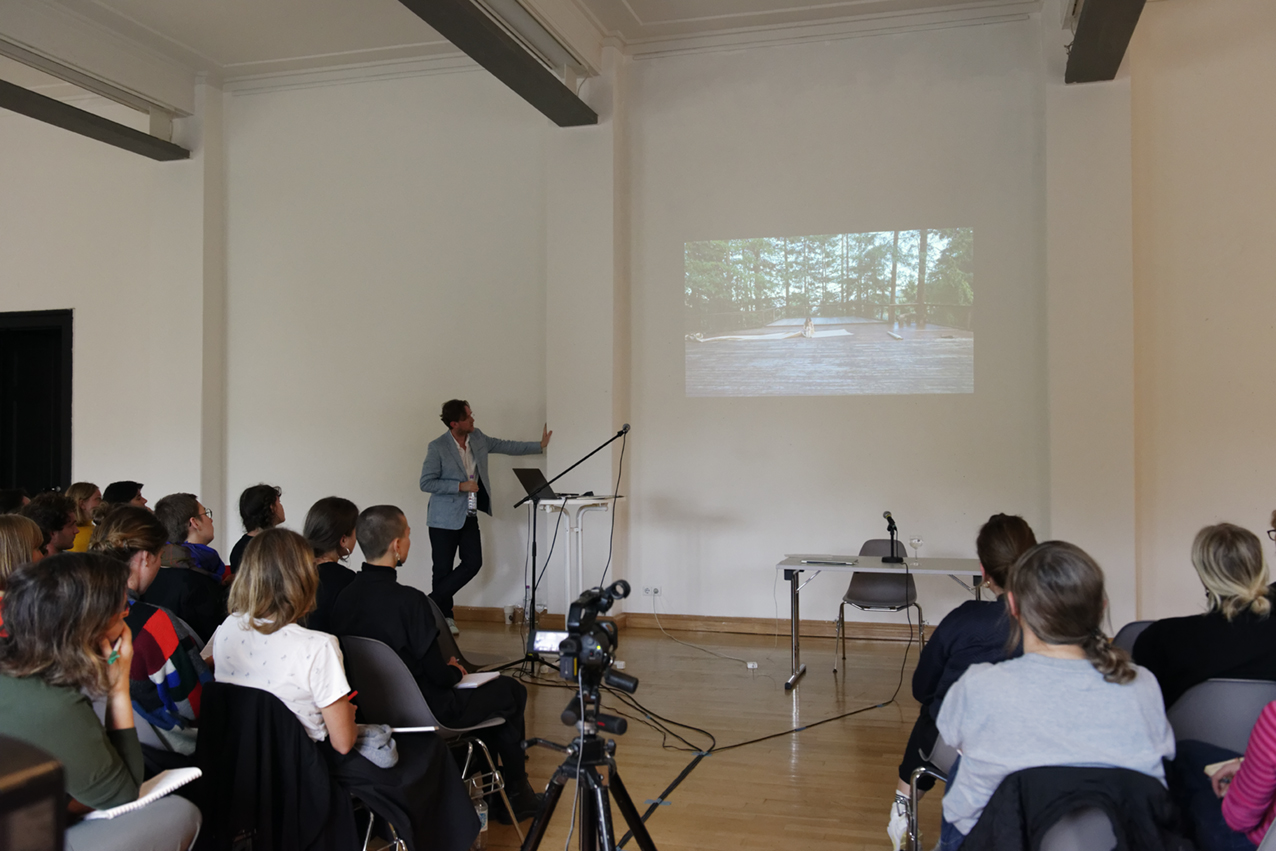
Show and Try Again, Symposium, 18 October 2019, HGB Academy of Fine Arts Leipzig. Adrian Heathfield (London): Spirited affinities
Credits: Photo: Sandra Schubert
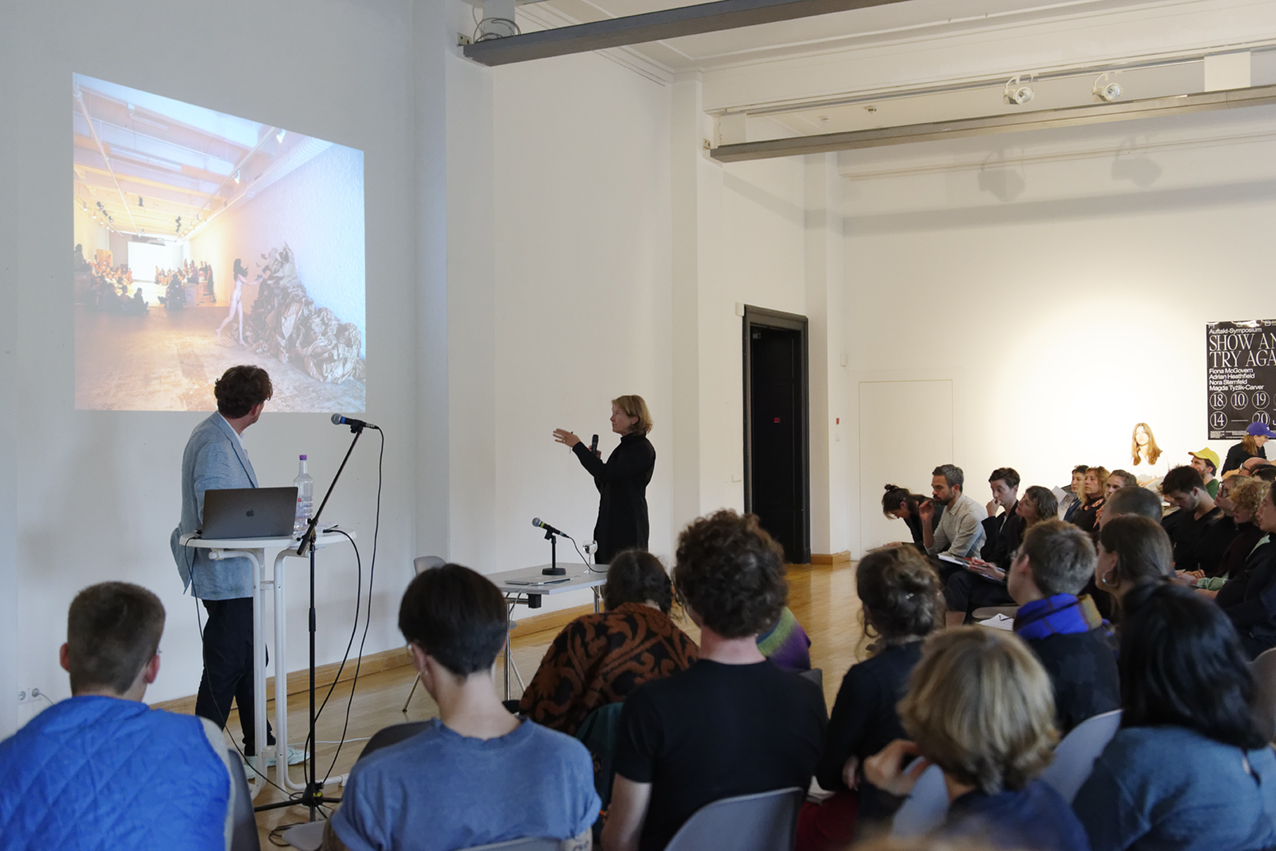
Show and Try Again, Symposium, 18 October 2019, HGB Academy of Fine Arts Leipzig. Adrian Heathfield (London): Spirited affinities. In conversation with Beatrice von Bismarck.
Credits: Photo: Sandra Schubert
Adrian Heathfield is a writer and curator working across the scenes of live art, performance and dance. He is the author of Out of Now a monograph on the artist Tehching Hsieh and editor of Perform, Repeat, Record and of Live: Art and Performance. He has curated a number of significant performance projects in museums, theatres and galleries including Live Culture at Tate Modern in 2003 and the Taiwan Pavilion at the 57th Venice Biennale 2017. Heathfield is Professor of Performance and Visual Culture at the University of Roehampton, London.
Space and Graphic Design
Joram De Cocker, Eva Dumoulin, Alexander Meyer, Lu Qijing
Joram De Cocker, Eva Dumoulin, Alexander Meyer, Lu Qijing
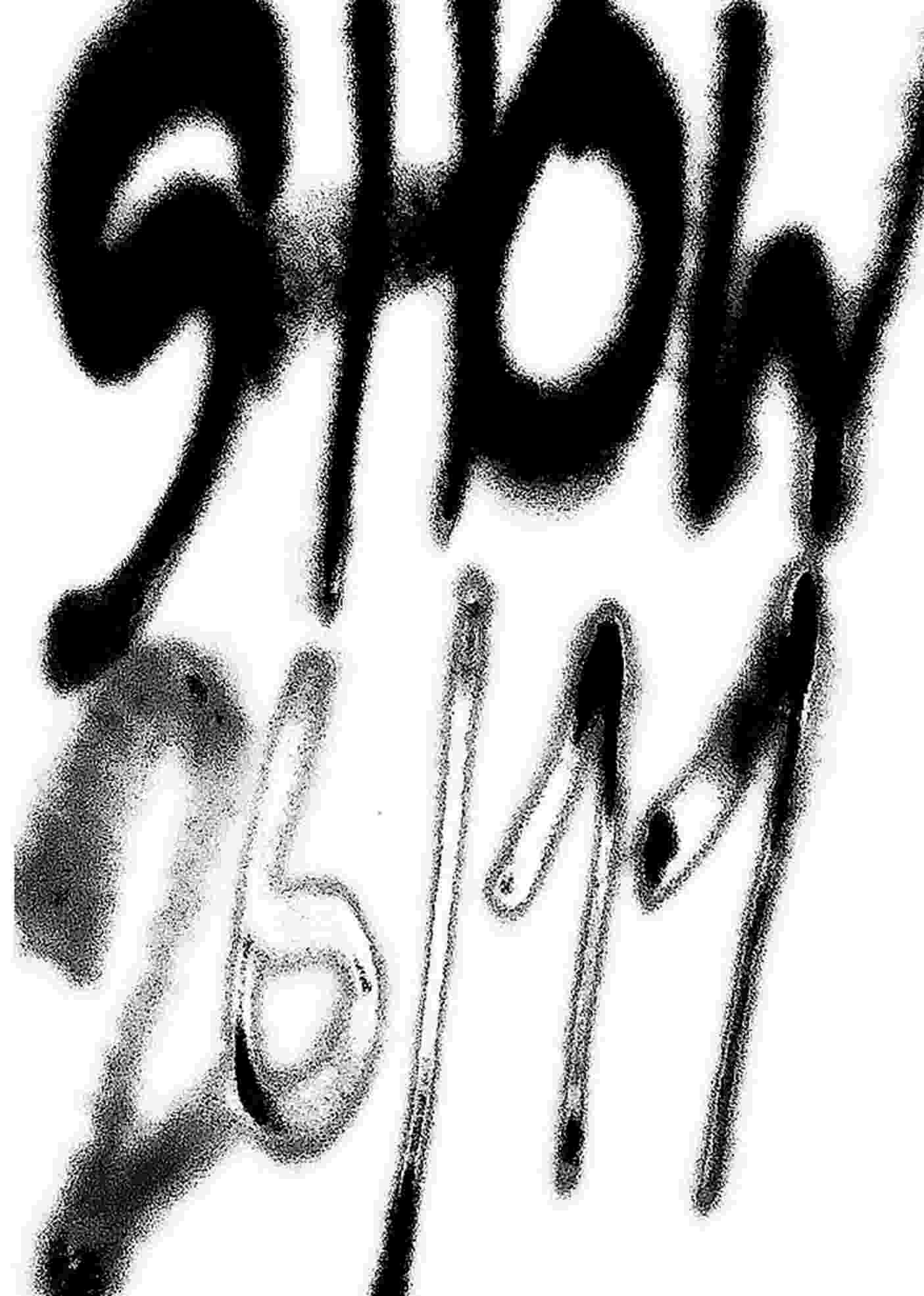
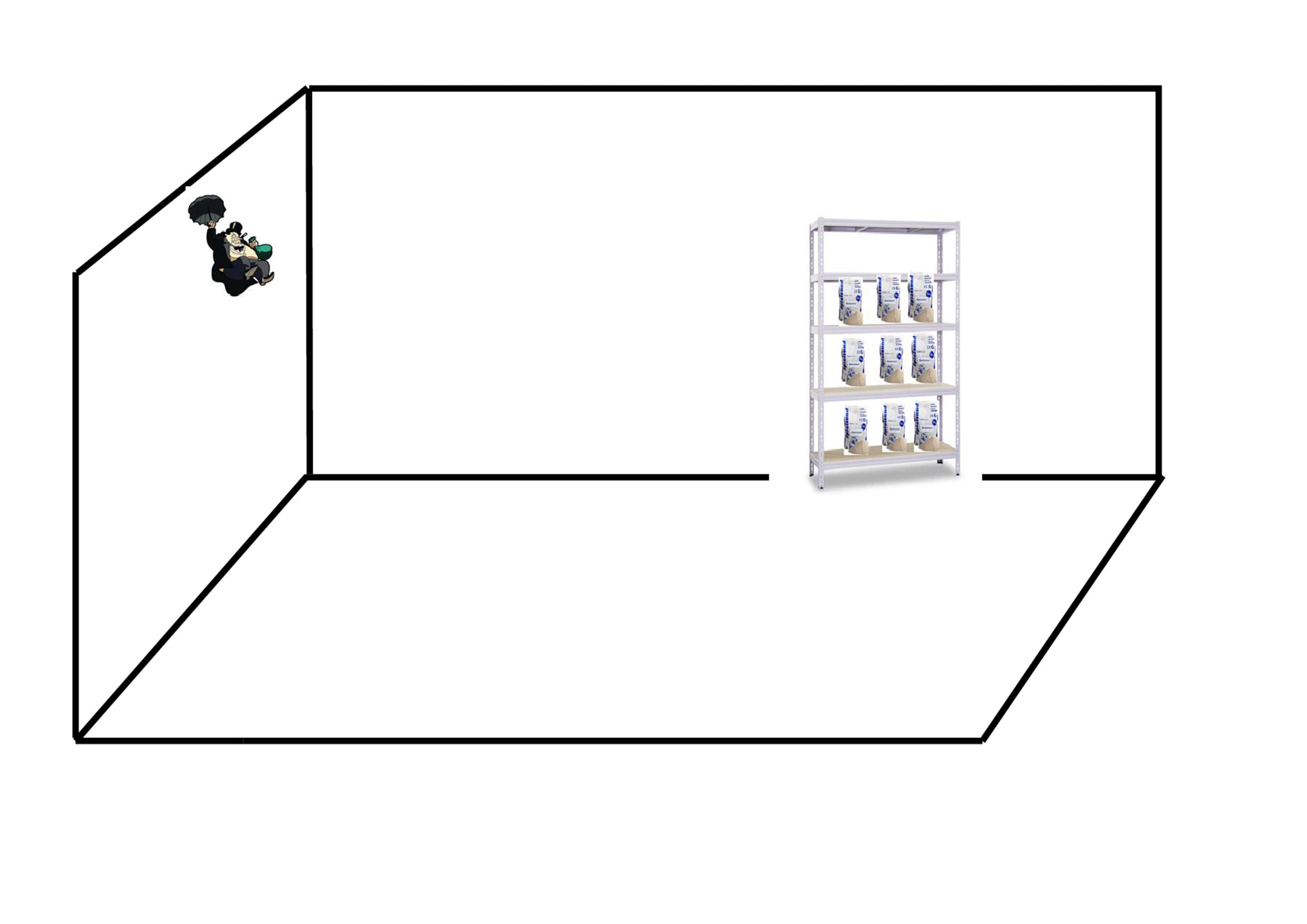
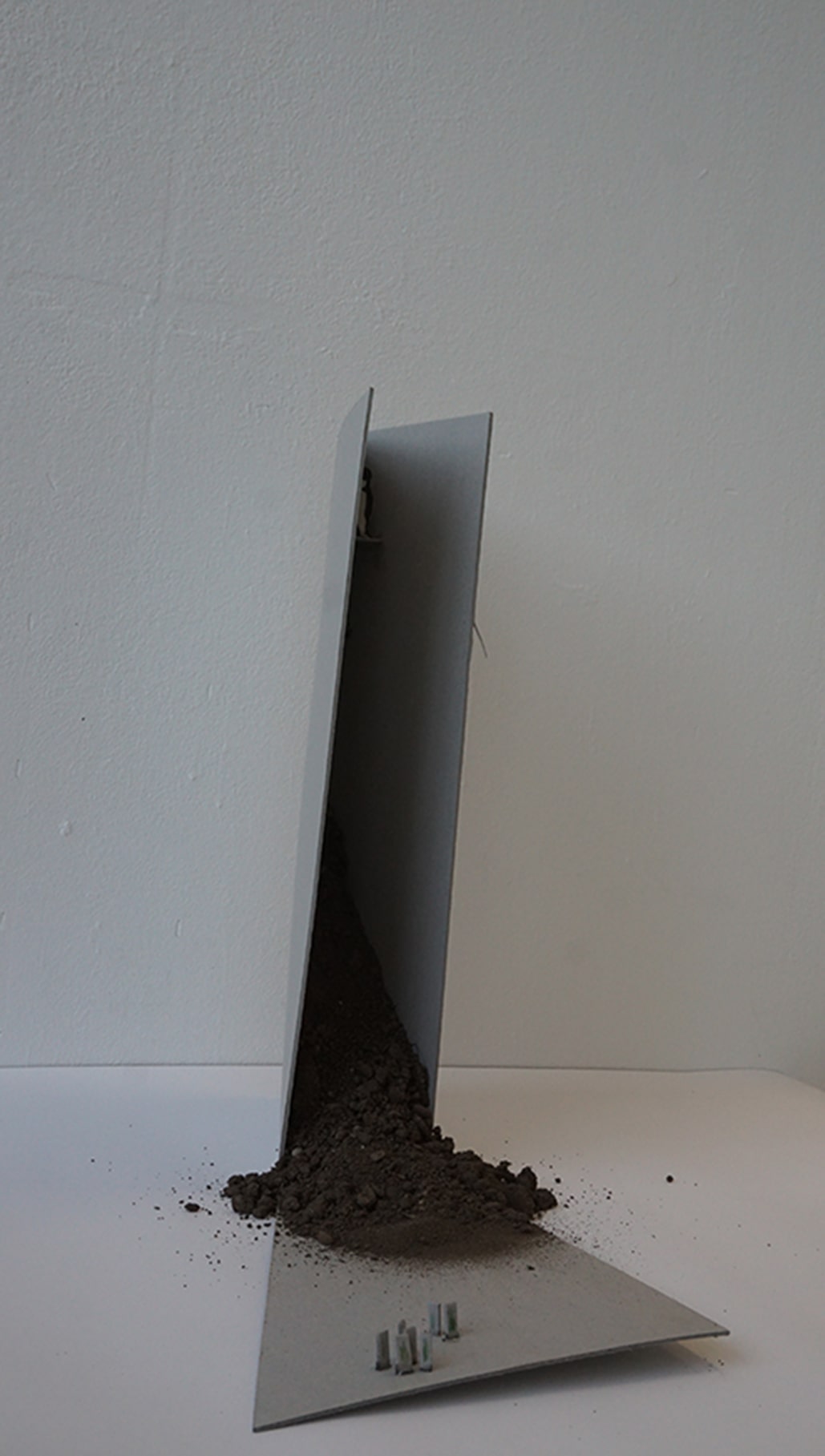
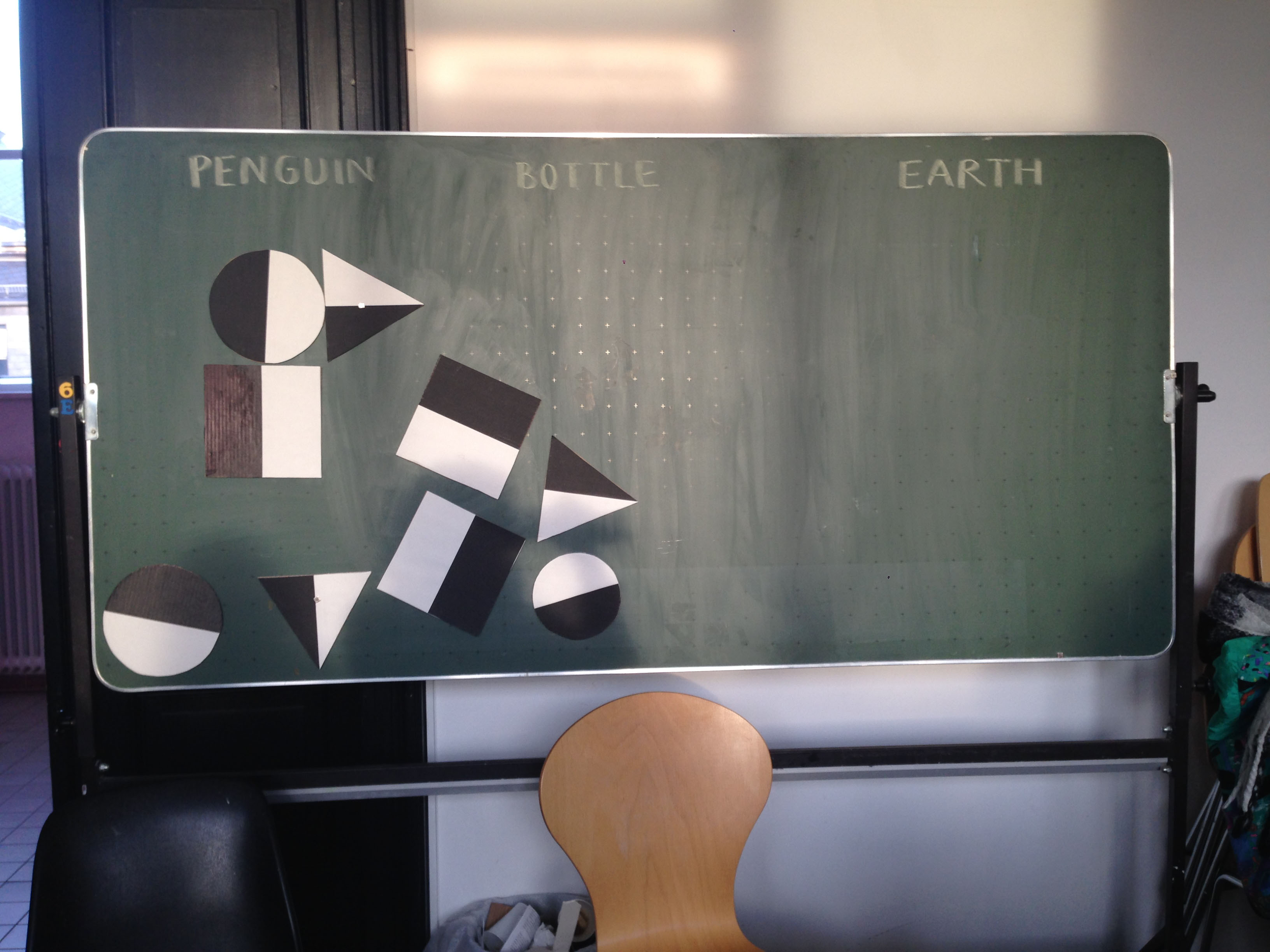
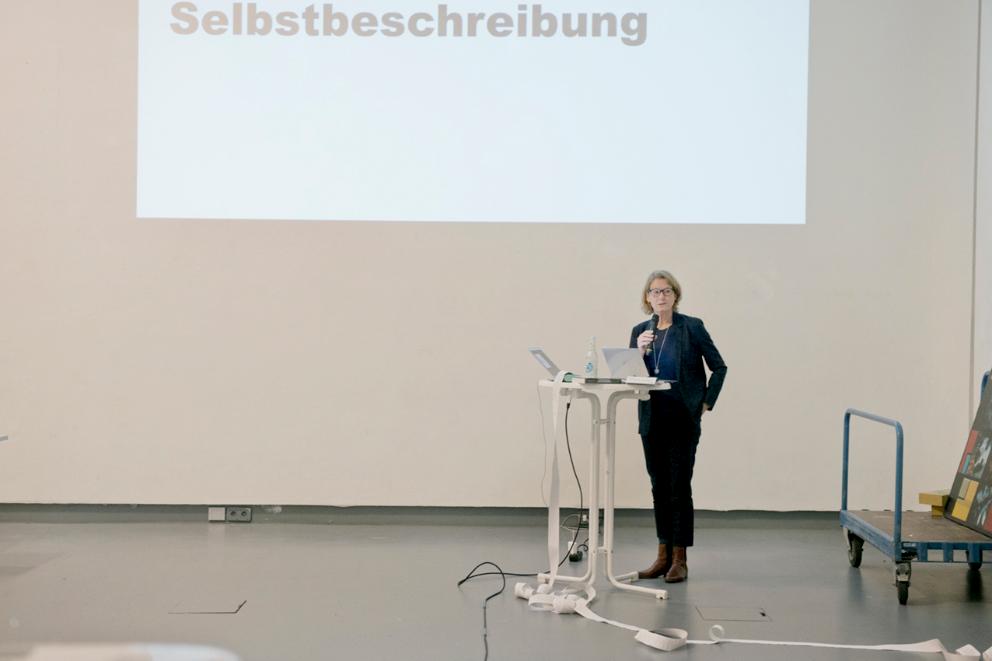
SHOW. Introduction by Beatrice von Bismarck, 26 November 2019, HGB Gallery.Photo: Raisan Hameed
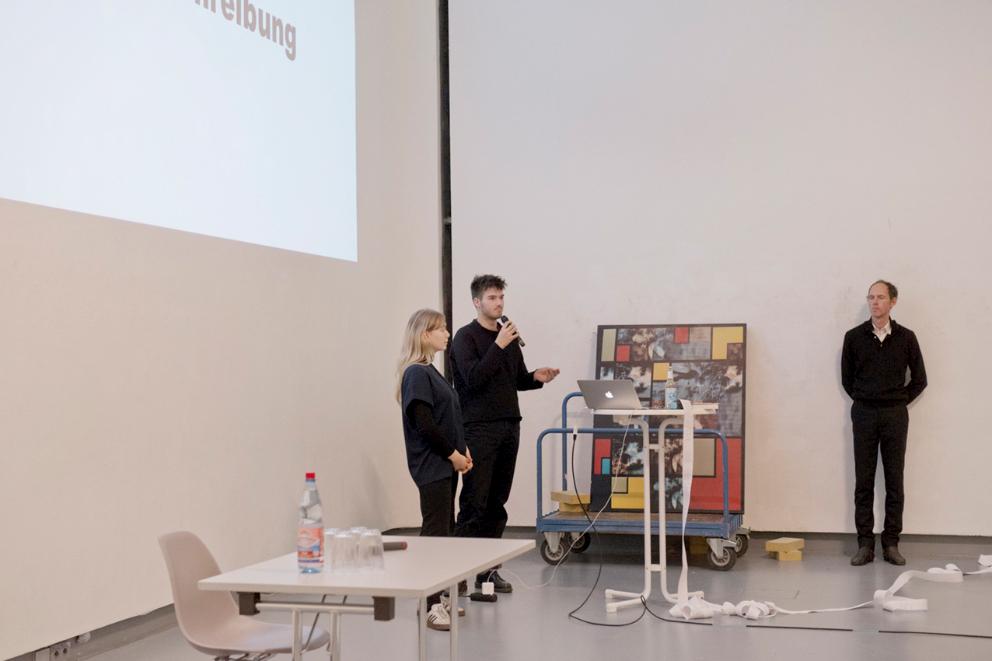
SHOW. Introduction to spatial concept realized by Joram De Cocker, Eva Dumoulin, Alexander Meyer, Lu Qijing, 26 November 2019, HGB Gallery.Photo: Raisan Hameed
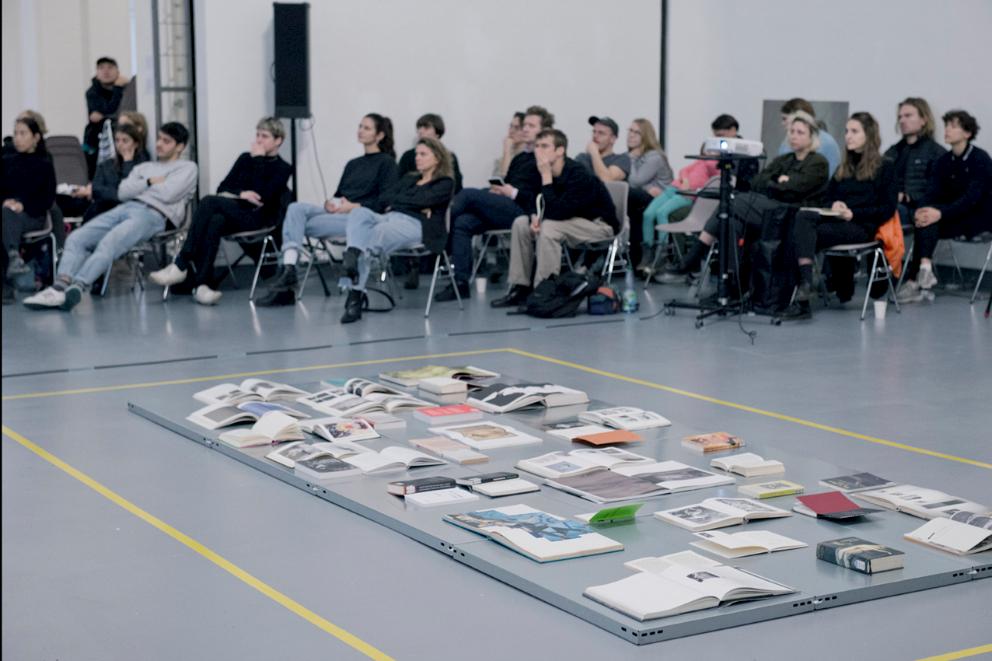
SHOW, Space and Graphic Design: Joram De Cocker, Eva Dumoulin, Alexander Meyer, Lu Qijing, 26 November 2019, HGB Gallery.Photo: Raisan Hameed
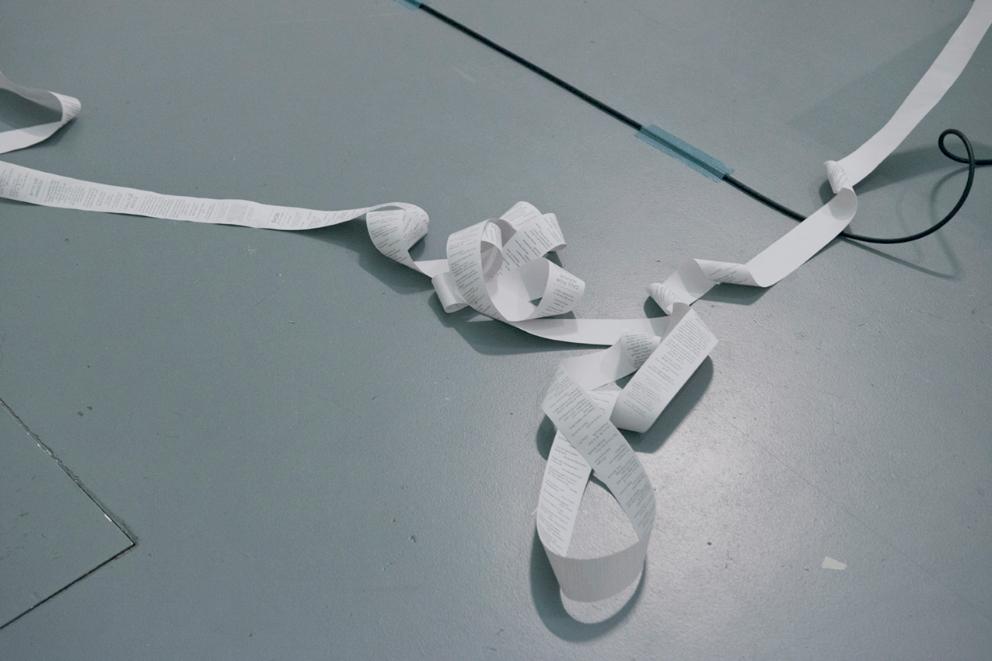
SHOW, Space and Graphic Design: Joram De Cocker, Eva Dumoulin, Alexander Meyer, Lu Qijing, 26 November 2019, HGB Gallery.Photo: Raisan Hameed
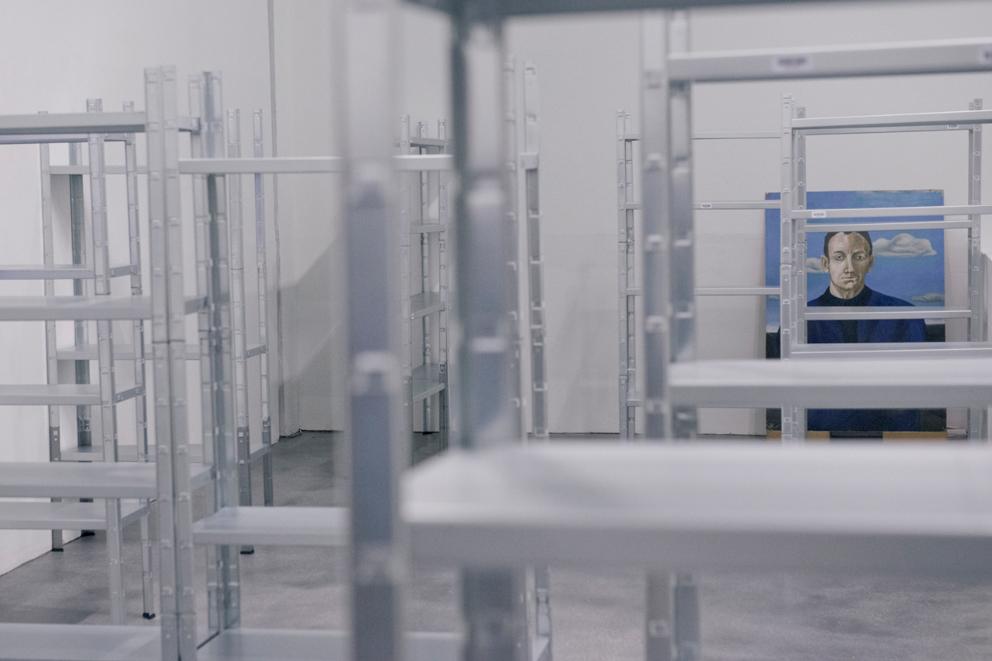
SHOW, Space and Graphic Design: Joram De Cocker, Eva Dumoulin, Alexander Meyer, Lu Qijing, 26 November 2019, HGB Gallery.Photo: Raisan Hameed
michael riedel
Lectured Lecture
Forms of
Self-Description
[read more ⤵]
“The need for commentary on art has been Riedel’s source of almost inexhaustible quantities of textual material since the mid-1990s, from which his imagery has systematically developed. From the paper bag with his name, which when put on makes him disappear as an artist behind the self-description, to numerous sound recordings that record his artistic life and make them readable in the form of equally extensive transcriptions, right down to the abundance of ready-made descriptive material that is generated by the increasing social message requirement on the World Wide Web, it is always the self-description of the art system, which Riedel takes up artistically and repeatedly communicates as ongoing work. The question, is this still art or merely the description of art that does not exist, remains open. The fact is that, in the last twenty years, the Riedel autonomist has impressively realized the artistic concept of self-perpetuating production mechanisms.”www.michaelriedel.net/mdbk
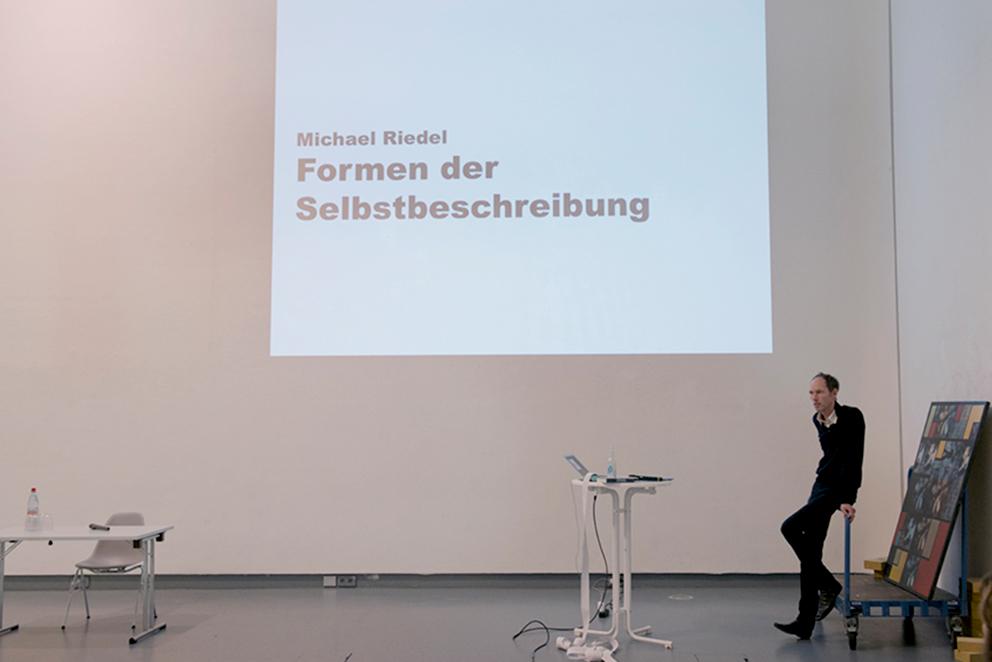
Michael Riedel: Formen der Selbstbeschreibung (Forms of Self-Description) | Lectured Lecture, 26 November 2019, HGB Gallery.Photo: Raisan Hameed
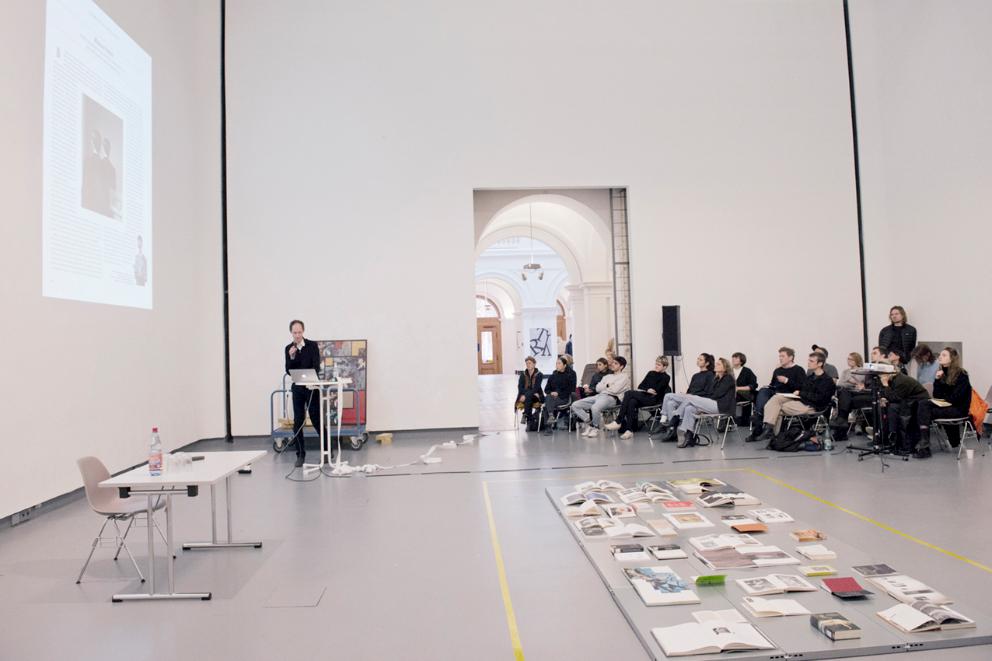
Michael Riedel: Formen der Selbstbeschreibung (Forms of Self-Description) | Lectured Lecture, 26 November 2019, HGB Gallery.Photo: Raisan Hameed
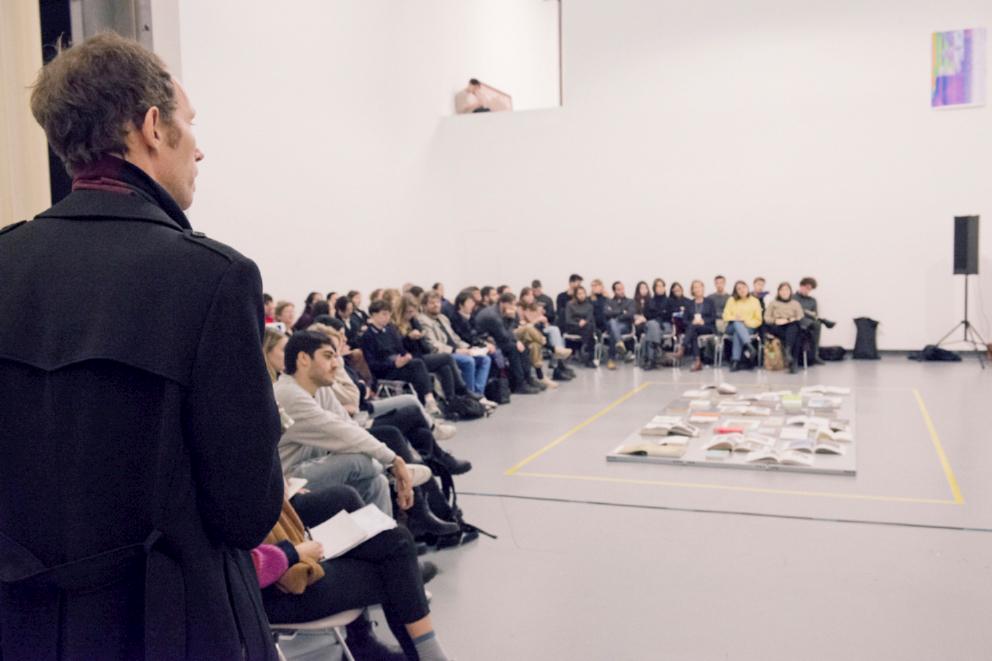
Michael Riedel: Formen der Selbstbeschreibung (Forms of Self-Description) | Lectured Lecture, 26 November 2019, HGB Gallery.Photo: Raisan Hameed
maureen mooren
Lecture
Exhibition Design
[read more ⤵]
How does exhibition design work as a practice of knowledge? What roles does it imply? How does a model relate to the actual exhibition space? In her lecture, Maureen Mooren talks about her role as a graphic designer for exhibitions and as an Art Director for Het Nieuwe Instituut in Rotterdam. Taking the exhibition making of Het Nieuwe Instituut as a starting point, she discusses the role of a spatial designer, the role of a graphic designer and the role of a curator.
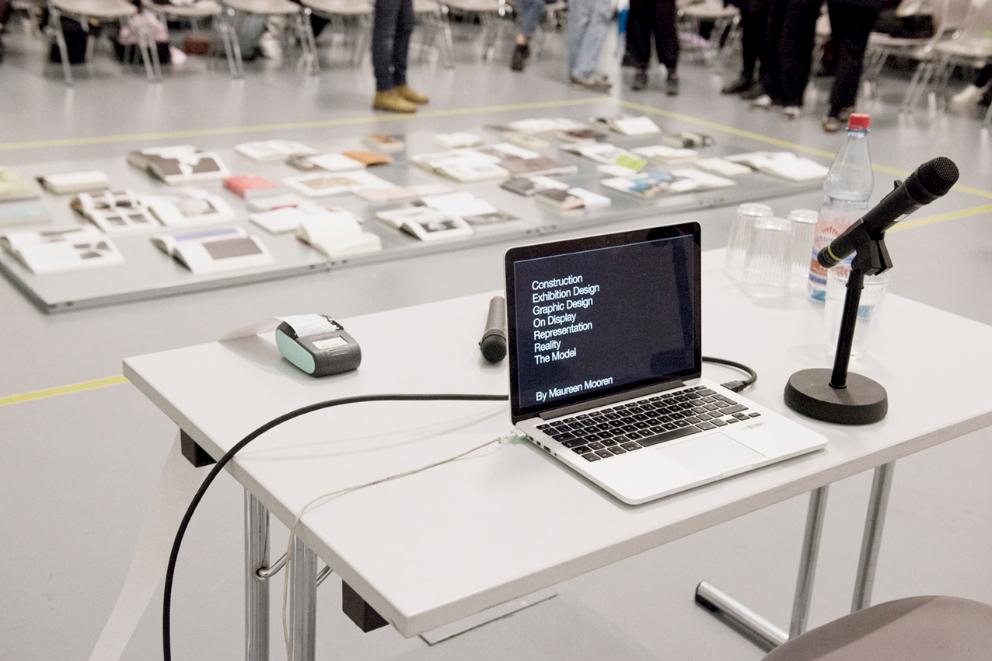
Maureen Mooren: Exhibition Design | Lecture, 26 November 2019, HGB Gallery.Photo: Raisan Hameed
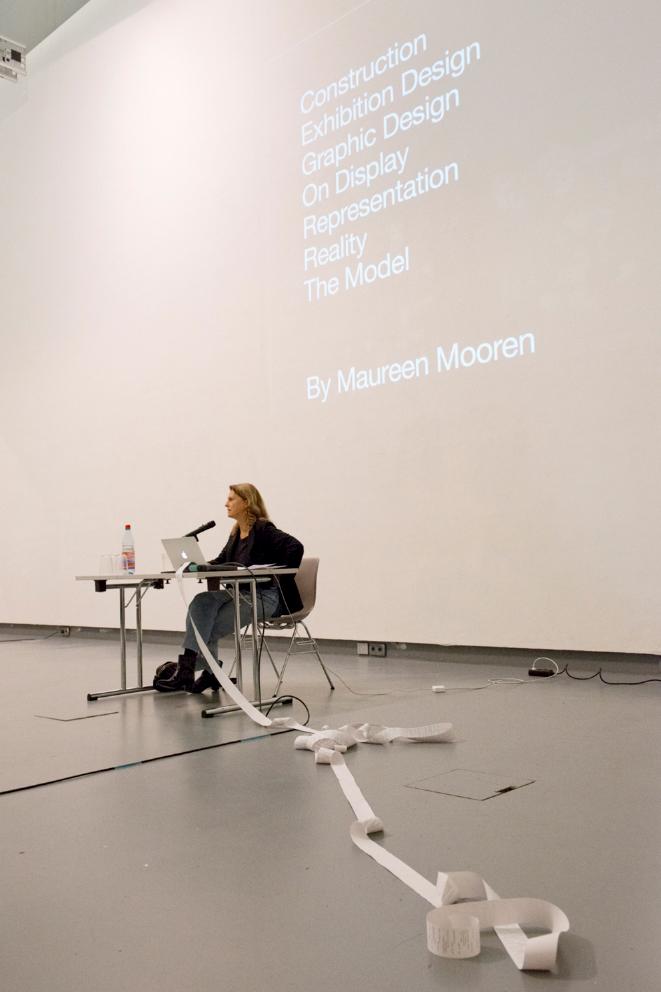
Maureen Mooren: Exhibition Design | Lecture, 26 November 2019, HGB Gallery.Photo: Raisan Hameed
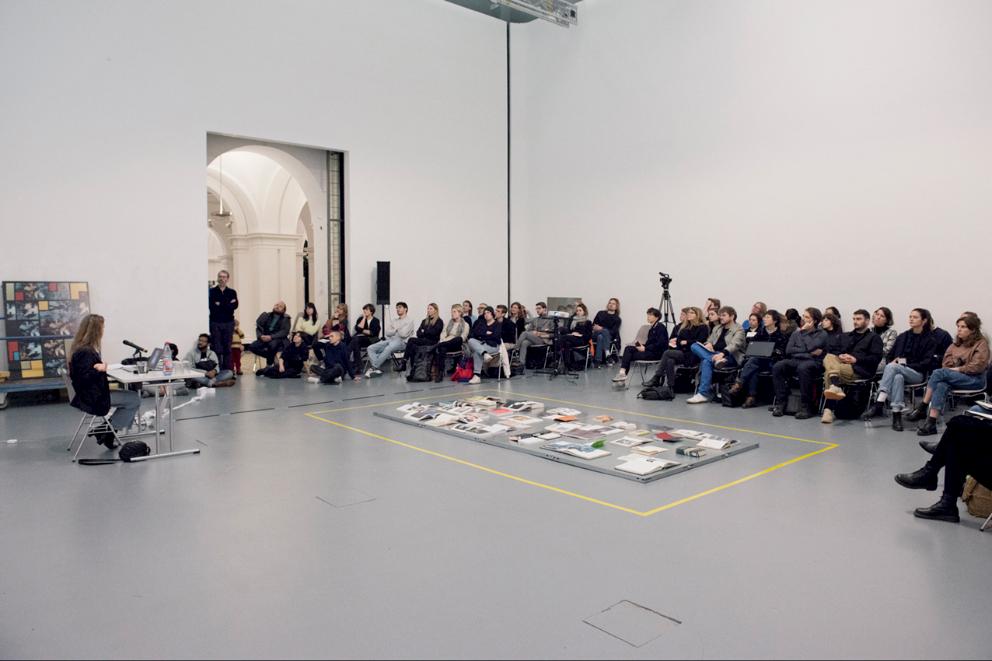
Maureen Mooren: Exhibition Design | Lecture, 26 November 2019, HGB Gallery.Photo: Raisan Hameed
thomas weski
Talk
The Invisible Part of the Iceberg
[read more ⤵]
When an exhibition opens, it is not just a process of research, selection and contextualization that lies behind it, but also a multitude of things that are not shown. That does not, however, make them less important, rather it provides the necessary foundation for everything that is shown. Thomas Weski calls this foundation “the tip of the iceberg” and discusses with Julia Kurz and Agnieszka Roguski, using the example of two exhibitions curated by him, how a body of work is made visible through various forms of attribution and authorship, presentation in space and the transfer of materiality.
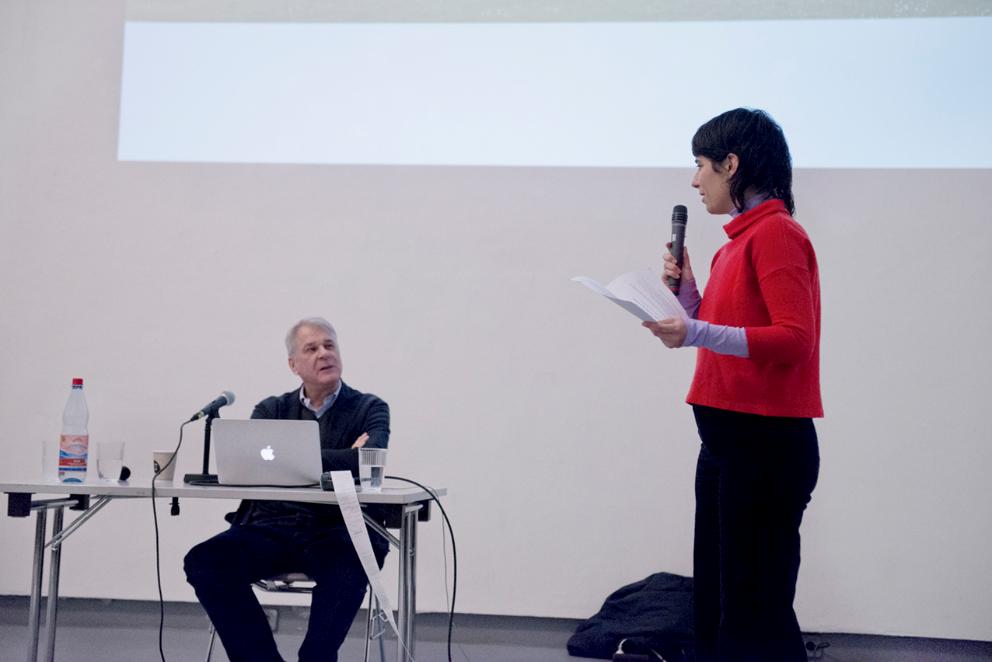
Thomas Weski: The Invisible Part of the Iceberg | Talk, 26 November 2019, HGB Gallery.Photo: Raisan Hameed
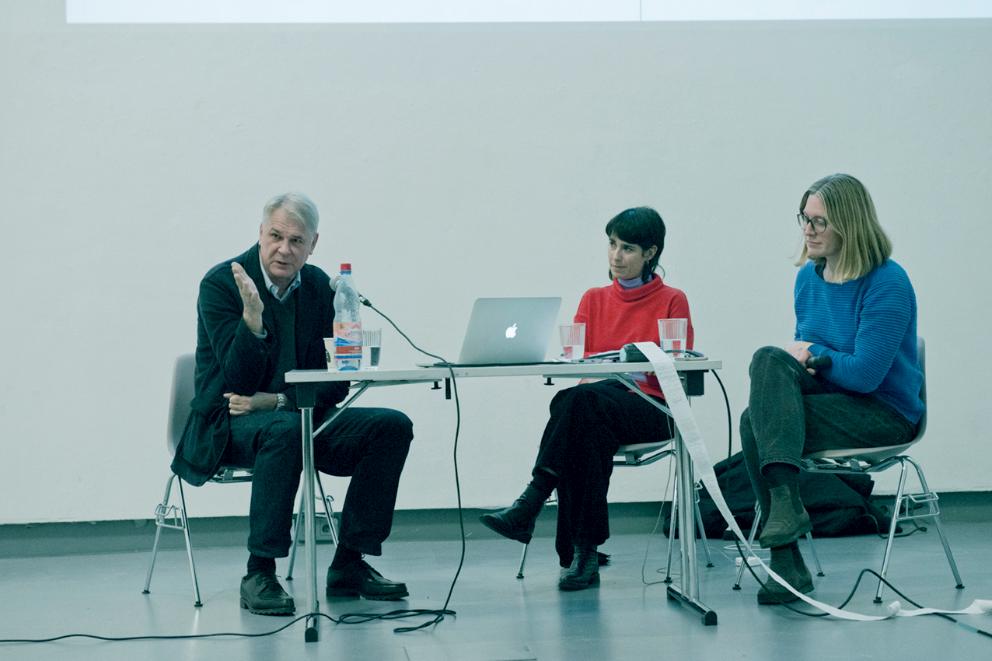
Thomas Weski: The Invisible Part of the Iceberg | Talk, 26 November 2019, HGB Gallery.Photo: Raisan Hameed
curatorial research
chris paxton
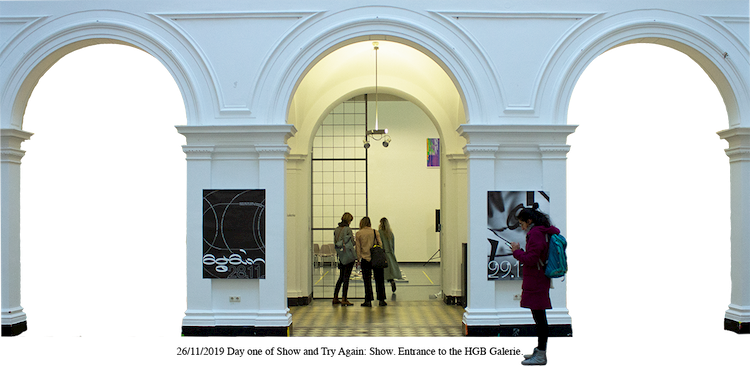
martin buhlig
Day 1—show
witness
curatorial
meaning production
summit
show
group
disappear
artist
guest
speaker
introduce
welcome
copy
machine
inside
outside
art-school
art
advertisment
wallpaper
picture
random
professor
foundation
museum
documenta
illusion
typography
money
automatic
appear
endless
judgement
critical
wall
floor
ceiling
painting
comment
publication
book
catalogue
edition
layout
design
content
lecture
practice
authorship
conversations
empty
reference
referential
system
visible
superfluous
media
format
body of work
transition
translation
transformation
process
nothingness
art
depiction
description
flow
group
pause
communication
aspects
metaphor
political
agenda
poster
art fair
biennal
archiving
fashion
shop
roles
art director
curator
designer
spatial design
identify
discourse
decision process
limits
power
task
duty
lines of conflict
responsibility
domination
respect
dialogue
position at the table
grid
archive
inspiration
idea
starting point
narrative
escape
public space
making images
iceberg
visibility
collaboration
filter
installation
artwork
photograph
inventory
drawers
studio
visuelles Haltbarkeitsdatum {visual date of expiry}
cohesion
exhibition architecture
space
sequence
material
research
analogue
digital
loss of information
vitrine
dead (material)
walk
reading
viewing
showing
places
react
center
core
vertical
display
image
order
rules
library
ethical questions
facsimile
preservation
view on
opening
develop
work for
professional
topic
promoted
source material
introduce
role models
epoch
commission
presentation
published
elements
installation
density
sides
the in-between
arranging
references
series
dummy
art history
about
excerpt
work in progress
artist-book
cover
invitation
body of work
contact-sheet
contact
personal
discussion
model
chronological
assistance
the artist
conservatory
struggle
sparring-partner
friends
access
opportunity
point of view
negotiation
arguments
metaphor
compromise
colleagues
hierarchy
lecture
the public
understanding
fear
perfection
balance
information
combination
practices of viewing/reading
visual
interest
vertical
horizontal
display
frame
condensed
backstage
representation
politics
showroom
touch
structure
organizing
scholars
dissertations
overview
thematic
inventory
paradise
opposition
asking
boundaries
decisions
figure it out
implementing
separate
to frame
make visible
choose
size
point
questions
avoid
prevent
story-telling
context
freelance
path
established
individual
the real world
parallel
simplicity
refined
one-man-show
time is running
know
workshop
mekka
pilgrimage
criticize
perspectives
phenomena
meeting
remarks
behaviour
rough/direct speech
recommendations
learning
the scene
autonomy
supporting
escorting
relevance
importance
speculation
duty
fight
envy
intensity
passion
escape
focus
touring
interpretation
fact
self-understanding
monopolize
withdraw
job
situations
access
key
persuasion
enable
peer-group
to profit
repetition
challenge
entertaining
lasting relationships
loosing interest
help
fruitful
continuous
regularly
professional friendships
comrades
asya yaghmurian
Show and try again?
Showing as non-action, as a state of being.
Treating show as a process that constantly evolves as on open space that welcomes new participants and ideas.
Accepting the neutral space and not treating the activities and knowledge as goods.
There is no ‘us’ and there is no ‘them’, there is no ‘inside’ and there is no ‘outside’.
We should talk more about art.
Trusting the process of the show, thus trusting the pause, the gap, the anarchic dimension.
Considering to not show, not try or never again.
Freeing the show, emancipating it from the structures.
Thinking about what to offer to the show and what to offer to try.
Questioning the show and questioning what do you want to show.
Finding the right addressee for the question.
Showing the try is already a show.
Showing the things that are not supposed to be shown.
Trying to show on behalf of others, the ones who don’t have the tools to assembly.
Trying to avoid the clashes of the show.
Being careful not to be stuck in the loopholes of the show.
Not bringing boredom to try again or to show.
Being careful not to cross the line between the show and the showoff.
Showing the assembly, not assembling the show.
Remembering and caring about the spectator who finally shapes the show.
Walking with the spectator through the show.
Imagining the show, as seen from non-show, assembly or try!
jana dohmann
QUESTIONING THE AFTER-SHOW
is the result of a field research—trying to capture the voices of the audience in the form of questions.
It created an archive of collected questions, that have grown out of the participation in the 5 days of Show and Try Again.
Following the approach of generating a living archive that stimulates new reflections and serves as a starting point for new discussions, this encyclopedia was translated into a game—that brings the manifold thoughts of visitors, participants, artists and initiators into motion and contact.
This format uses the active, discursive qualities inherent in the nature of the questions and tries to catalogue some of the experiences of the various participants in the program.
You are cordially invited to download the game and question the follow-up of the program-week in a playful way.
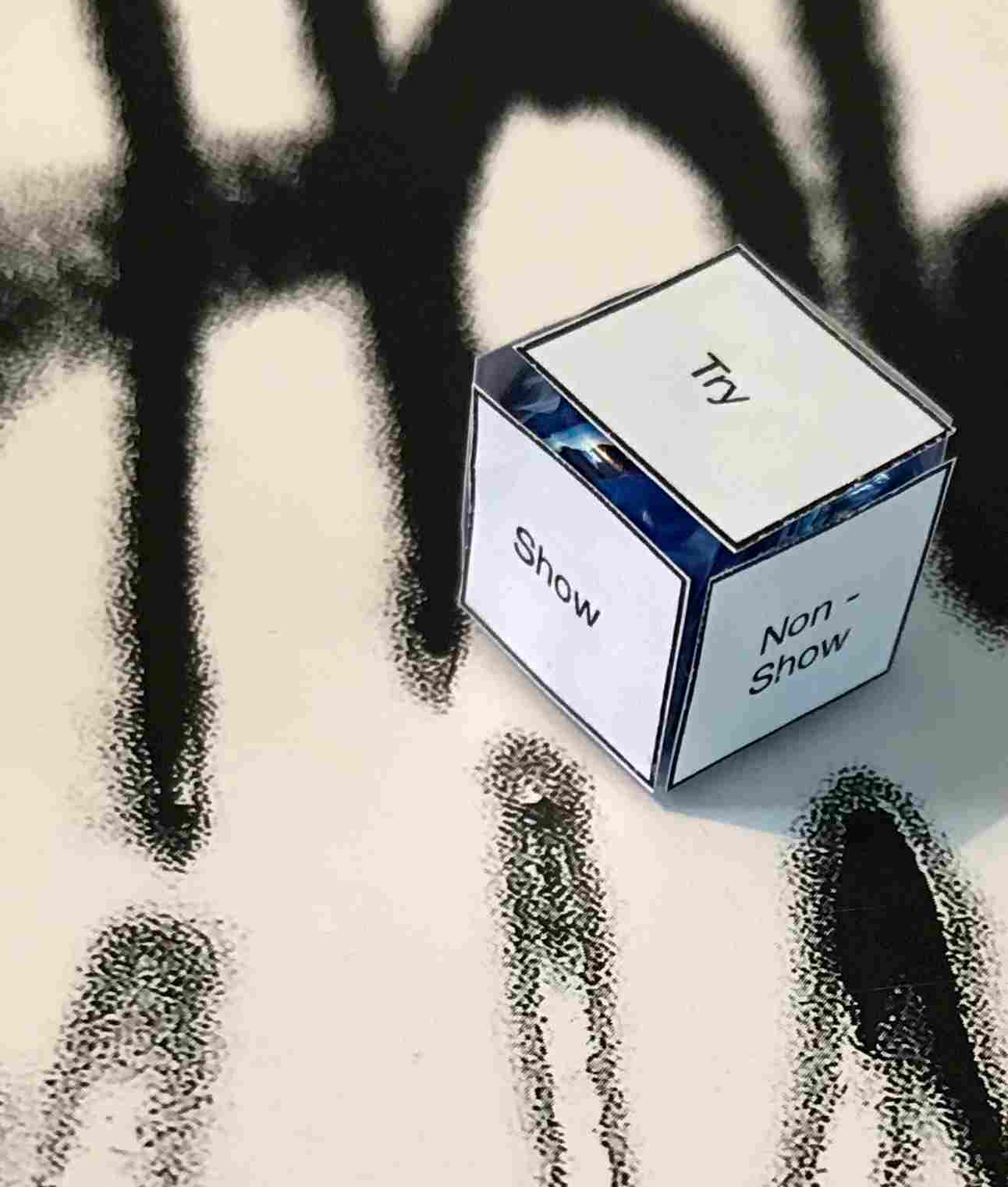
How can the act of showing be shown itself?
How does exhibition design work as a practice of knowledge?
How does a model relate to the actual exhibition space?
As an artist how to get rid off responsibility in the context of showing?
Sehen Sie sich mehr als Dadaisten oder als Konzeptkünstler?
Würden Sie das Nichts erkennen, wenn ich Sie nicht darauf hinweise?
What is a work and what is not a work?
What does it do when there is always light on?
Welche Position nehme ich ein?
How does your position as an art director influences your position as a graphic designer?
What ist the relation between producing & showing?
What is the function of an archive when it is empty?
Where do you get your information from?
Can you be befriended with the artist as a curator?
Was für eine hierarchische Beziehung besteht zwischen KuratorIn und KünstlerIn?
Wie kritisch darf & muss ich in meiner Rolle als Kuratorin zur Arbeit & Person der KünstlerInnen stehen, mit denen ich arbeite?
Warum diese Beiträge bei Show and Try Again?
Welche räumlichen Bedingungen führen zu Passivität?
Welche Bedingungen verhindern sie – im Kontext von Veranstaltungen wie Show and Try Again?
Why is the idea of order so important for an artist and how does it affect your work as a curator?
What happens if, in places where the information is supposed to be given, it is not accessible to the visitors?
Imagine a library where you are not allowed to touch the books, how do you behave in such a setting?
Which day would you have chosen to work with it curatorially or artistically?
Does exhibiting the work of a photographer, which is specifically very photographic, makes the photographer an object of photography?
Are libraries places of public knowledge? In which way—if at all—can libraries be understood as democratic?
Inwiefern fördert der Einsatz von Technik – im Kontext einer öffentlichen Präsentation – eine Routine der Performance?
What is a healthy number of exhibitions per year for a curator?
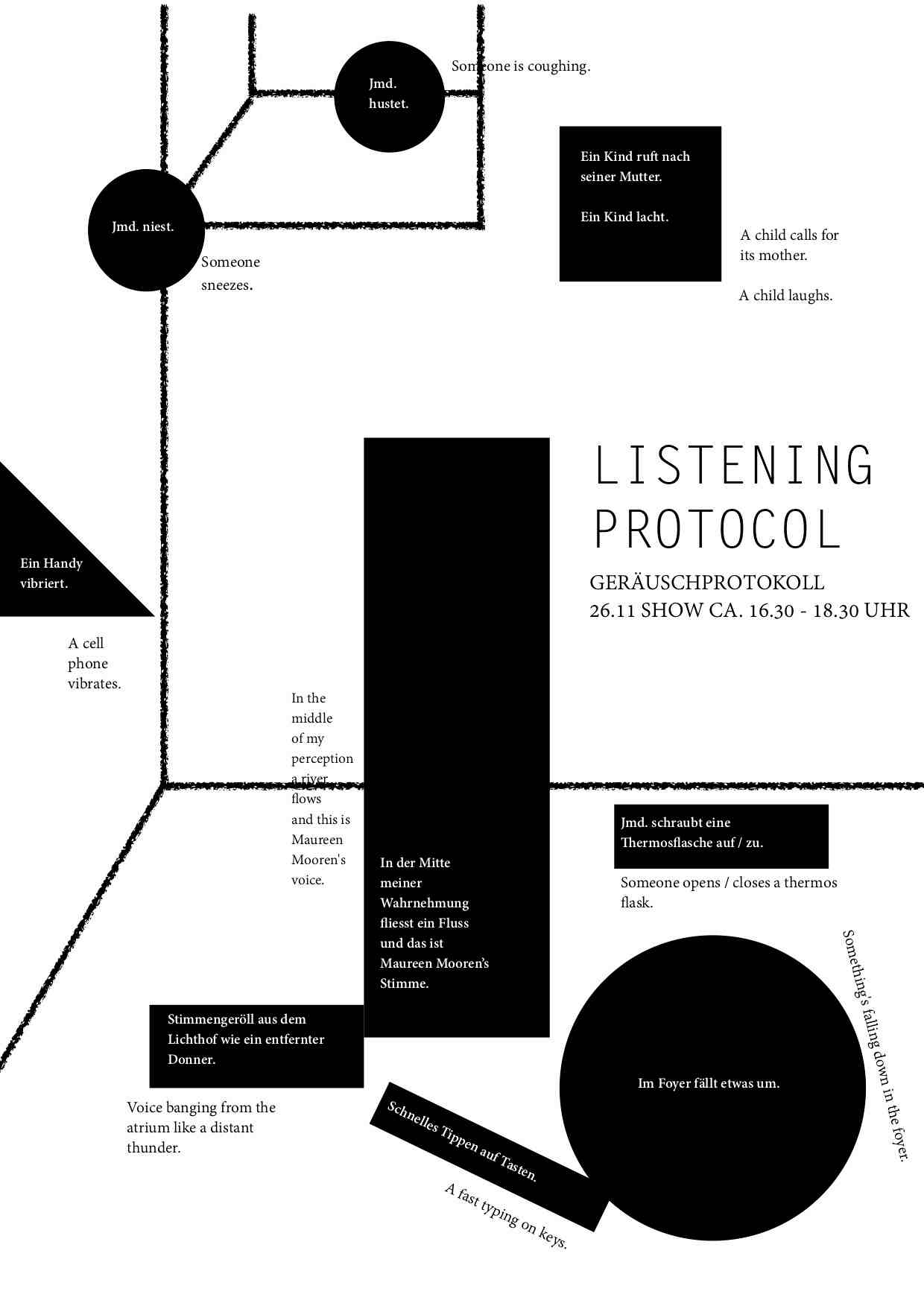
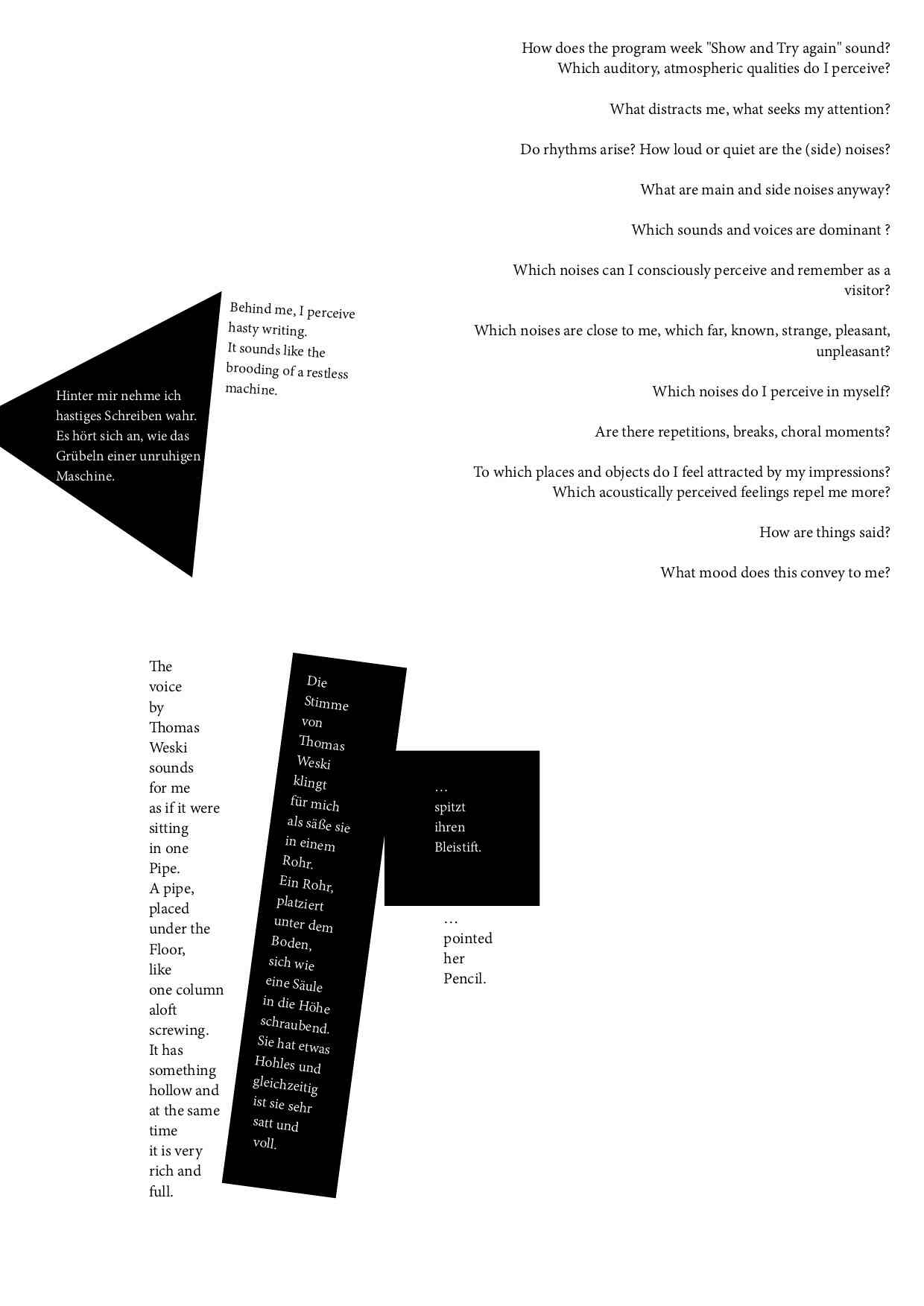
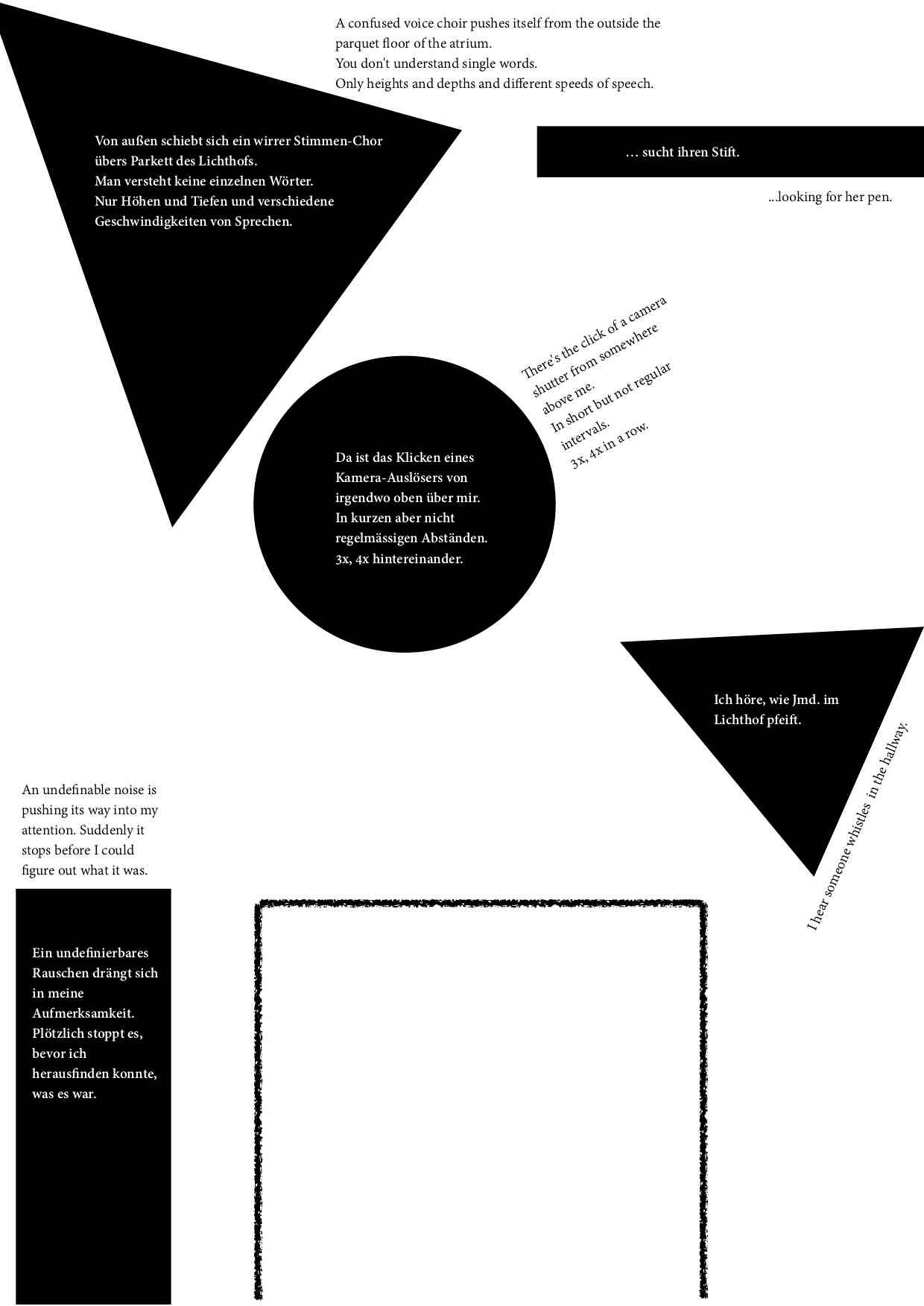
nuhsin atmaca
The missing link—Ethical dimensions of translating
Translation as a curatorial practice helps to make things visible, it helps to understand, and it helps to include audiences that would otherwise be mere onlookers. It also helps to clarify what has been aware of, what has been acknowledged, thought through, and nevertheless abandoned. It enables the curator/the curating artist to add a letter to his/her sent-off that opens up at least one of the many possible perspectives of contextualizing a curatorial project and in its reflective character is able to give justice to those that are directly or indirectly affected by the curatorial work. It is thus an inherent aspect of a curatorial approach that takes the ethical dimension seriously and as such a useful if not necessary tool to reflect on / the process of / showing.
So what happens if the curatorial fails to translate / the process of / showing? Translation being understood as both translating from one language to the other as well as translating expertise and knowledge, words, phrases and expressions for those that are not part of the inaugurated circle (yet).
Once it forgets, or even worse, refuses to translate, the curatorial and thereby the art and culture it is showing either redevelops into or continues to be an exclusive space. It thus cements the hegemonic and dominant structures it itself—as a critical practice—heavily questions. In the very moment of omitting translation, the curatorial perpetuates them.
But translation as a curatorial practice does not only mean to translate the sent-off as it is seen from a curatorial perspective, it also implies translating it in as many different perspectives that can be possibly thought of—in order to detect ethical pitfalls and to develop a position on it. Here, translating would enable the curatorial to become aware of its own privileges, its subjective perspectives, and enable it to deal with them in a politically conscious way.
Translation offers the potential for a curatorial practice to become accessible for and respectful to different audiences, thus making the meaning produced relevant in many more ways while at the same time escaping the danger of self-referentiality and self-centrism. But is there an ethical duty to translate? Out of respect for different audiences and the awareness of their diverse perspectives, there is. With regard to artistic freedom and freedom of expression, there isn't. It is this dilemma between curatorial freedom and social and political responsibility which the curatorial needs to address every time anew, taking a conscious ethical decision every single time.
How did you feel in the space?
Such long sessions not only attack the mind, but also the body. So I think that these active breaks are important where one moves.
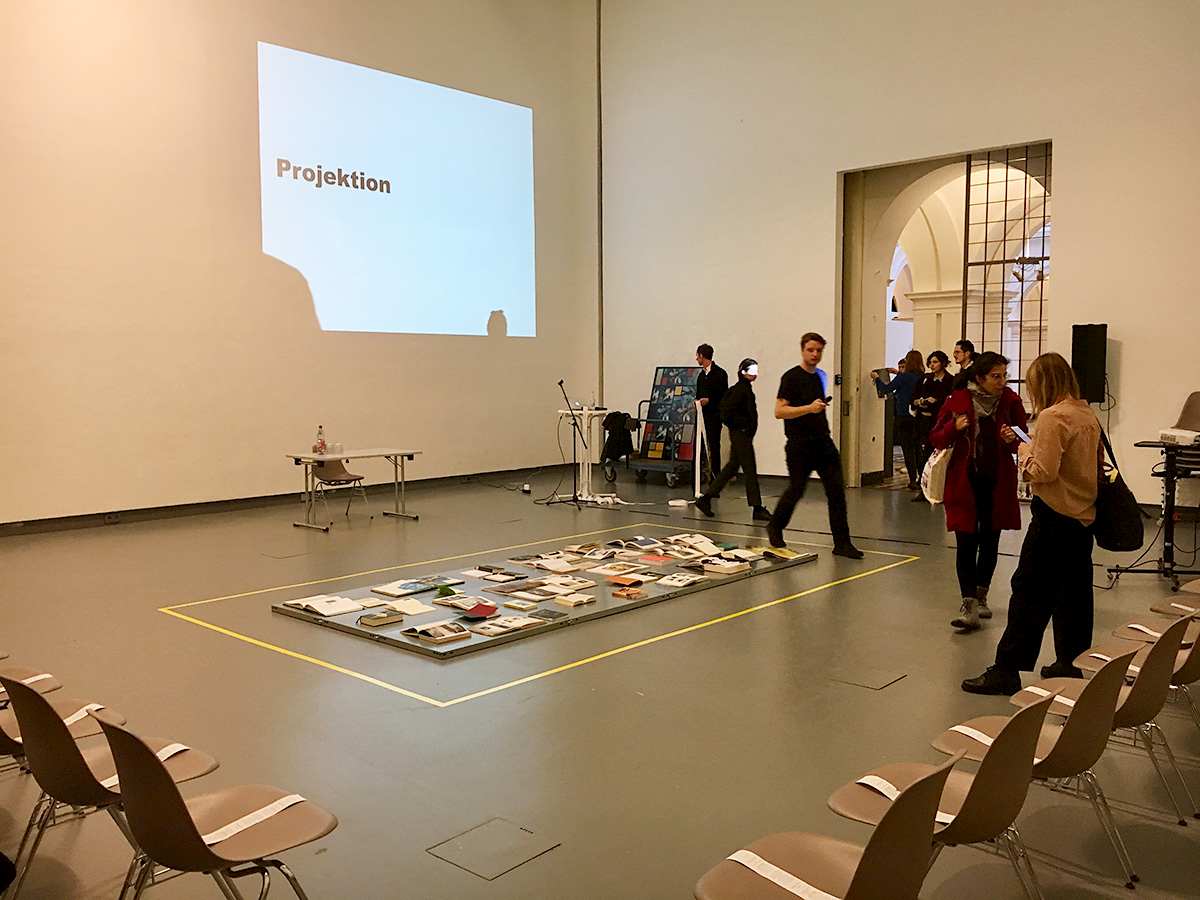
I always like sitting on the floor with lots of cushions and stuff.
You almost had the feeling as a participant that you should be as little noticeable or disturbing as possible.
Do you think that there is a connection between your own physical position and the reflection you might have?
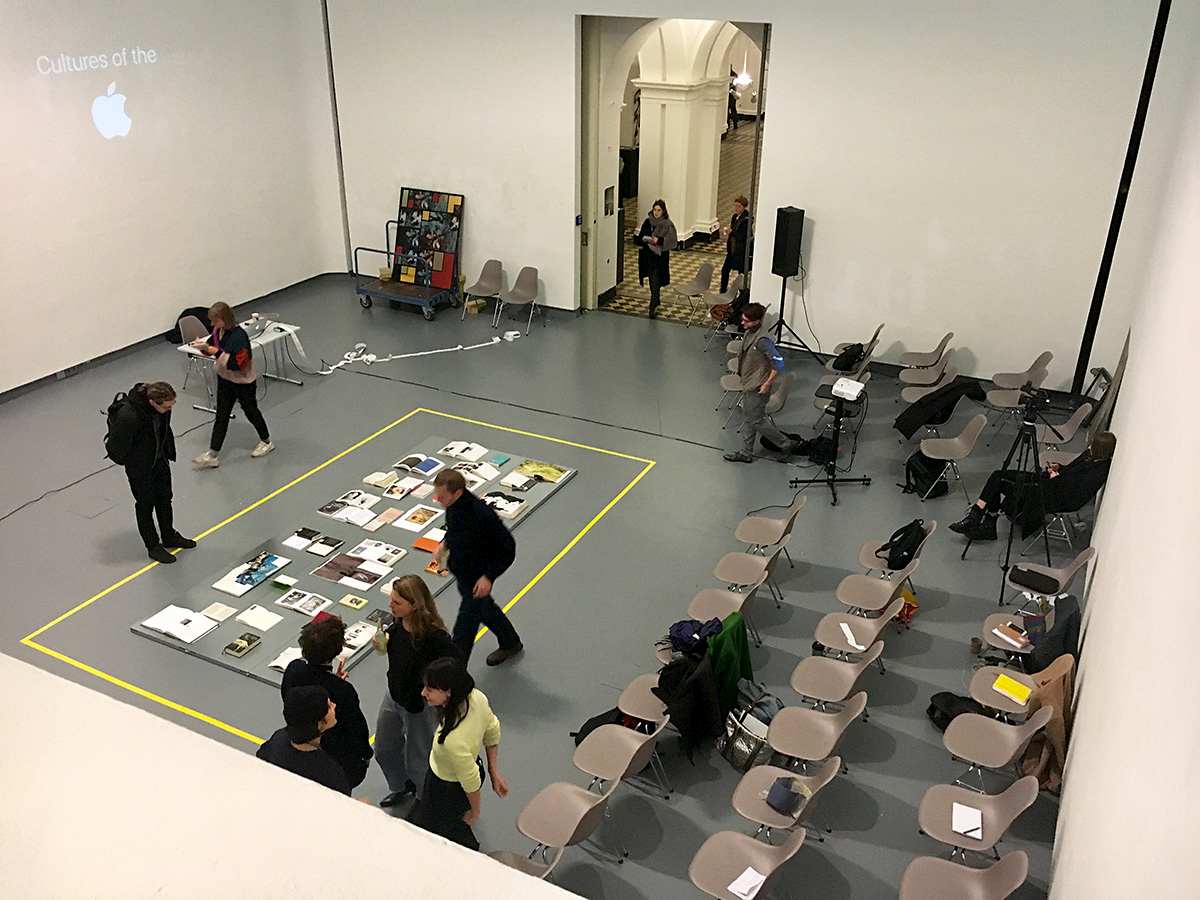
Nowadays the white cube plays the same role as the white book page for modern literature or the white canvas for modern painting. The empty white cube of space is the zero point of exhibition practice - and therefore the constant possibility of a new beginning.
nadine vollmer
Memory Shots
27 November, 2019 7.31am
A dark sonorous and friendly voice.A person too tall for the table he sits at.
Contact sheets of streets in Düsseldorf in black and white, projected onto the wall behind him, slightly moved to his left side.
Photographs of Berlin, black and white as well.
Düsseldorf as Düsseldorf looks like, still looks like, even if it is 1976 over there.
Berlin as Berlin doesn’t look like anymore.
A photo caption: “Ausländische Mitbürger am Landwehrkanal.” (Foreign citizens at Landwehrkanal. Although ‘ausländisch’ has a different taste than ‘foreign’, more bureaucratic.) Until when did one write it like that. Privileged situation(s). Longstanding relationships. “Comrades in a socialist sense”, Thomas Weski says.
Männerfreundschaften. (There is no equal word for this in English. Friendships between men. Male bonding. Never women.)
On the one side the space: the stage (without looking like a stage at first sight, no elevation, no borders) with table, chair, microphone, laptop, a glass of water. On the other side rows of chairs, theatre style, pressed to the wall. Grey on grey. In the space in between, on the floor: a plate, grey as well, on top of it opened books, surrounded by a yellow borderline.
A blurred S in a Dutch accent makes two English words sound identical. Projects become products. The plate is a trench, without any overlaps, without displacement, no tectonics.
A young-sounding voice that parries critical inquiries in a friendly but somewhat slightly attacked manner. A lecture that is said to have been given just as often. Material generates itself only from material. No light from the outside. Circling. When will the paper just be empty, finally. What would happen if I just left or turned my back on the show over there?
You show me pictures, I show you _____ what?
“A circle does not only define what’s inside but also what’s outside.”
Whoever dares to enter the space will be absorbed. A chair on the doorstep is the most comfortable place to watch. The distant and faint hum of some electrical device. There is a world outside. And there is coffee (waiting for me).
Die Grenze verläuft nicht zwischen oben und unten, sondern zwischen dir und mir (The border does not run between above and below, but between you and me) was once written on a firewall of a house where there used to be a wall. The Wall. At some point it was painted over and then there was a Nike advertisement.
You’re standing over there, I sit over here, and if we’re lucky a spark will leap the gap and I will continue to think your thoughts.
birgit messmer
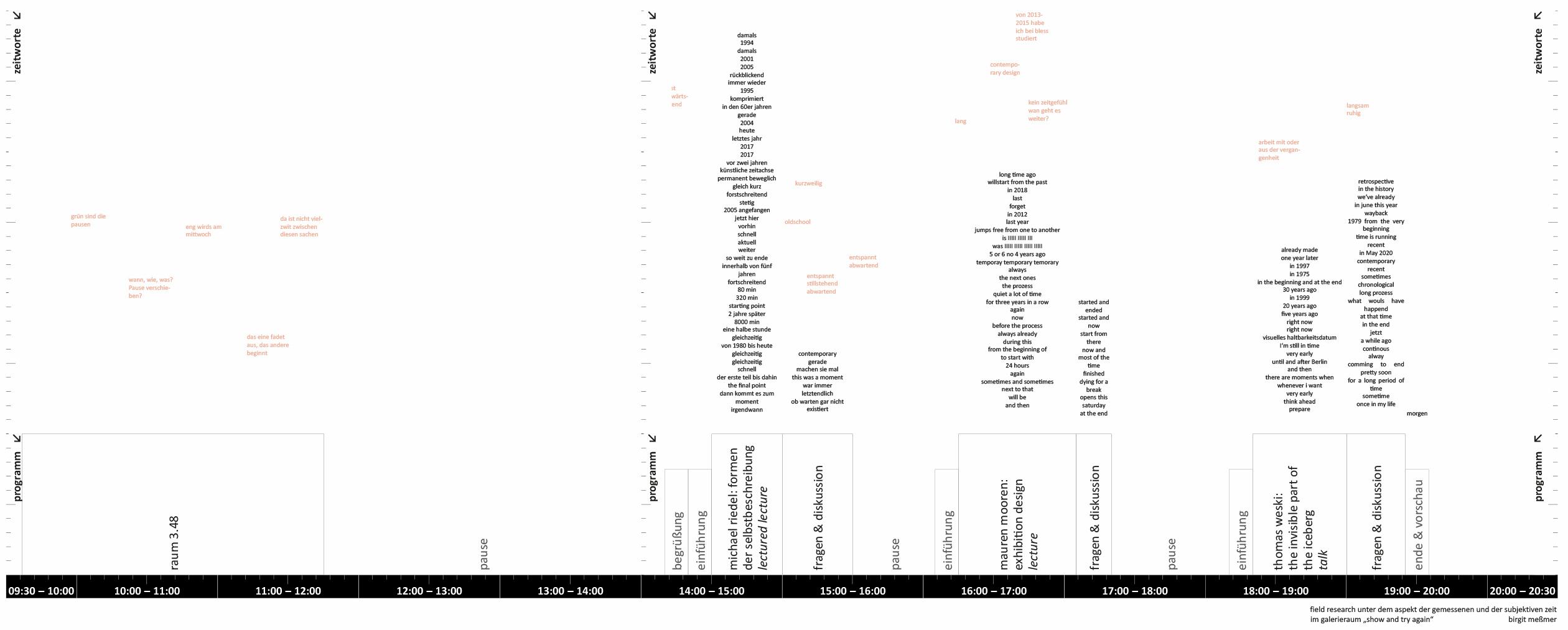
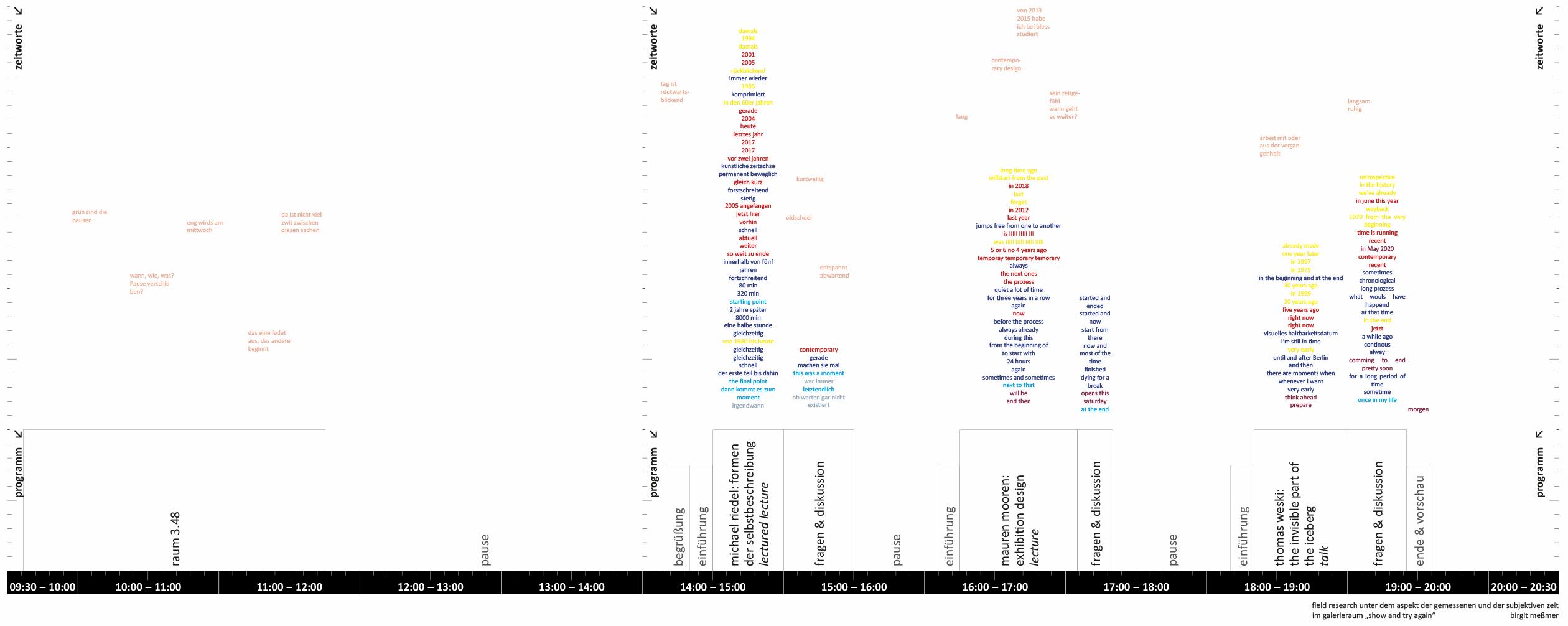
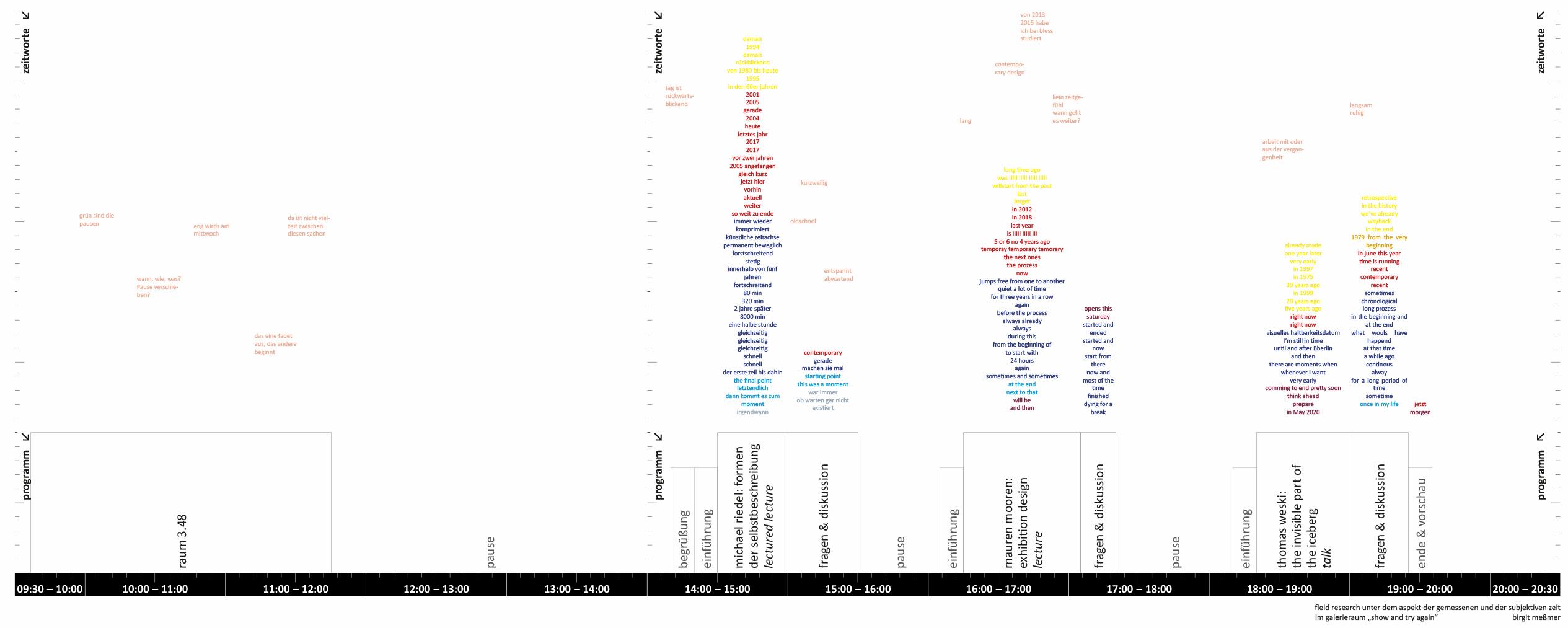
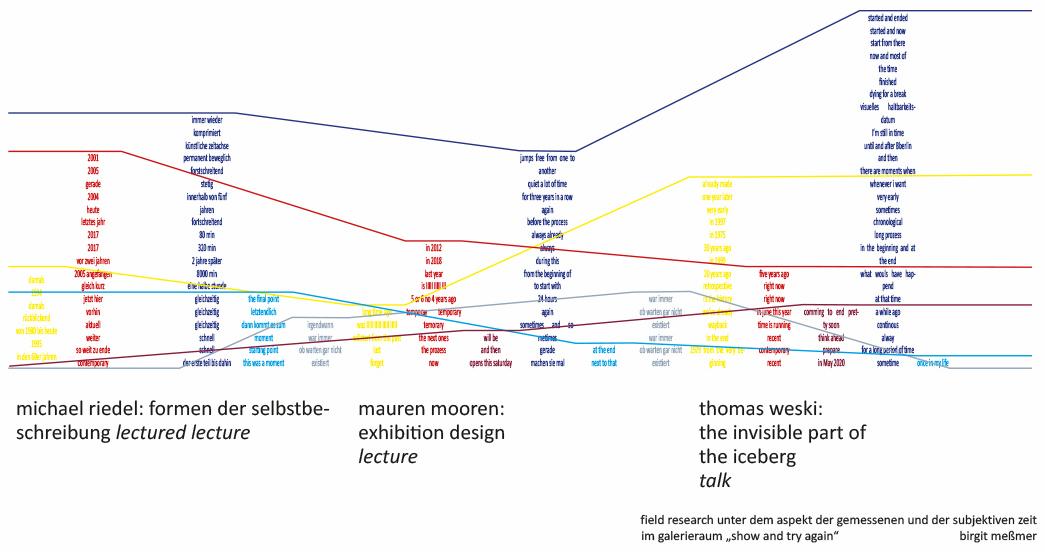
jonas von lenthe
Does your art make a difference outside of the art?If I feel that the question could be disqualified, I feel uncomfortable.
After Michael Riedel’s lecture you were the first from the audience to ask a question. What was your question?My question was related to the fact that Michael Riedel said his art was also representative of something. The question had to do with that, but I wasn’t sure if I dared to ask it: What does your art change outside the art system? Because, he also said that art is there to change something and make a difference. I was interested in whether it still makes a difference outside this system, also in relation to what Beatrice said in the introduction about art in a socio-political context.Did the idea of the question come up during his lecture or afterwards? The idea came during his talk. His art is very self-referential and I was wondering why. I missed this contextualization in his lecture. He mentioned at the very end that it represents something. In his answers to the other questions it also became clear that his world somehow works like this: There is a system, you take something out of it and feed it back into the system. It became clearer to me then. This aspect was not so accessible for me at the beginning and I asked myself how I could access it. Is it just about him, or is it also about something else? How serious is this self-referentiality? Do you do it because you think you are so amazing, or is there something else behind it? I couldn’t quite grasp it.Were you nervous?Maybe a little bit because... you wanna know why?Yes please!The lecture was very art-oriented. I feel that I don’t know much about art; I am lacking an expertise in this field, I look at it from the outside. The answers to my questions might be obvious for some: He said things like ‘as art students you will know that’ or ‘everybody in art school knows that’. I’m not necessarily familiar with these things. And sometimes Michael Riedel blocked the question and pointed it back to the audience, like for example Benjamin’s question, to which he first answered, ‘I didn’t understand your question’. His tone was a bit rude. If I have the feeling that the question could also be disqualified, then I quickly feel uncomfortable. I got upset about that and therefore I was a bit insecure.But it quickly became clear that your question would not be disqualified, right?That’s right. I had to ask one or two questions, but once I was talking, it was ok.Do you think that your question led to an opening of the situation?I think it opened up a bit later. There were two more questions, between which it took a little time for people to get in touch. After that, the mic was passed pretty fast. There was a moment when it was almost over, but Michael Riedel said he would like to take a few more questions. I found that very positive and encouraging.
Panorama!I just wanted to help quickly
You made the first comment during the lecture by Maureen Mooren. What was it?Maureen Mooren searched for a word, then I said the word.What word was that?Panorama.What made you feel addressed and respond?I first waited to see if someone else said something, because I wanted to help but I didn’t feel the need to be the one to say something. But I didn’t want to wait too long either, because I think that makes the situation awkward. So I just wanted to help quickly and so I said panorama.Would you say that this led to a general opening of the situation? Did the audience feel more invited to participate after your comment?I don’t know, that’s what I sometimes ask myself too. Well, it would be my hope that others would then feel more encouraged to say something, but I don’t know if that’s really the case.Do you think your comment has changed in any way Maureen Mooren’s way of navigating through the lecture?For a moment I wasn’t sure if the fact that she didn’t know the term herself made her feel insecure. But I had rather the feeling that it loosens up when you get feedback from the audiene and that my attention was also increased afterwards.